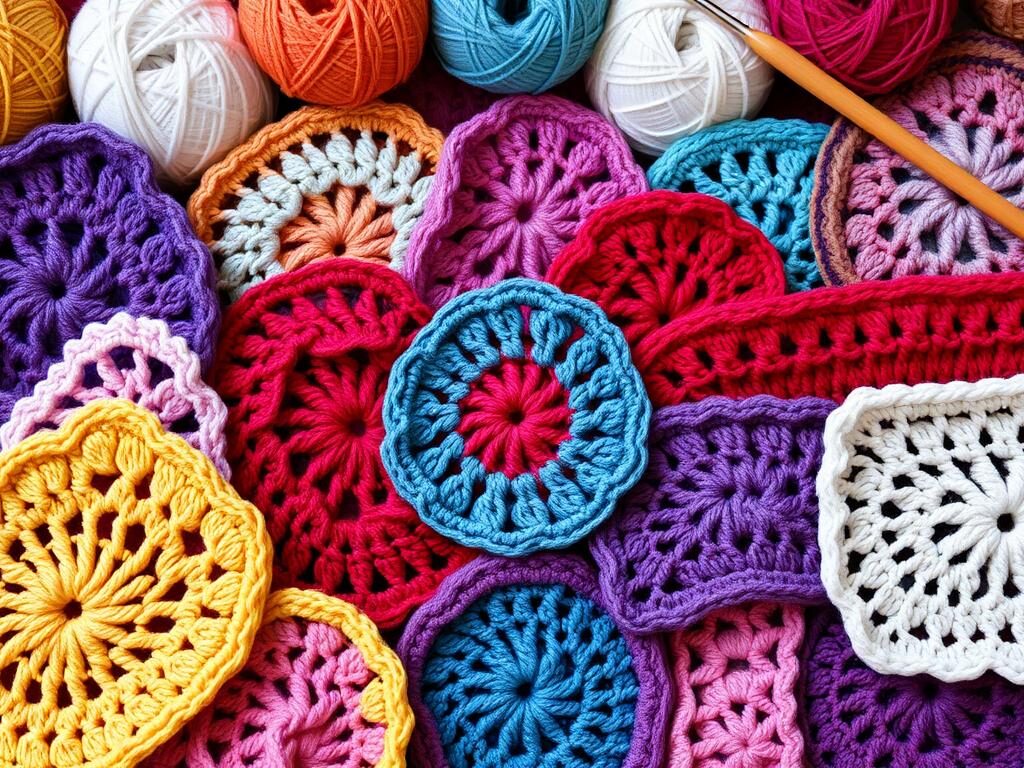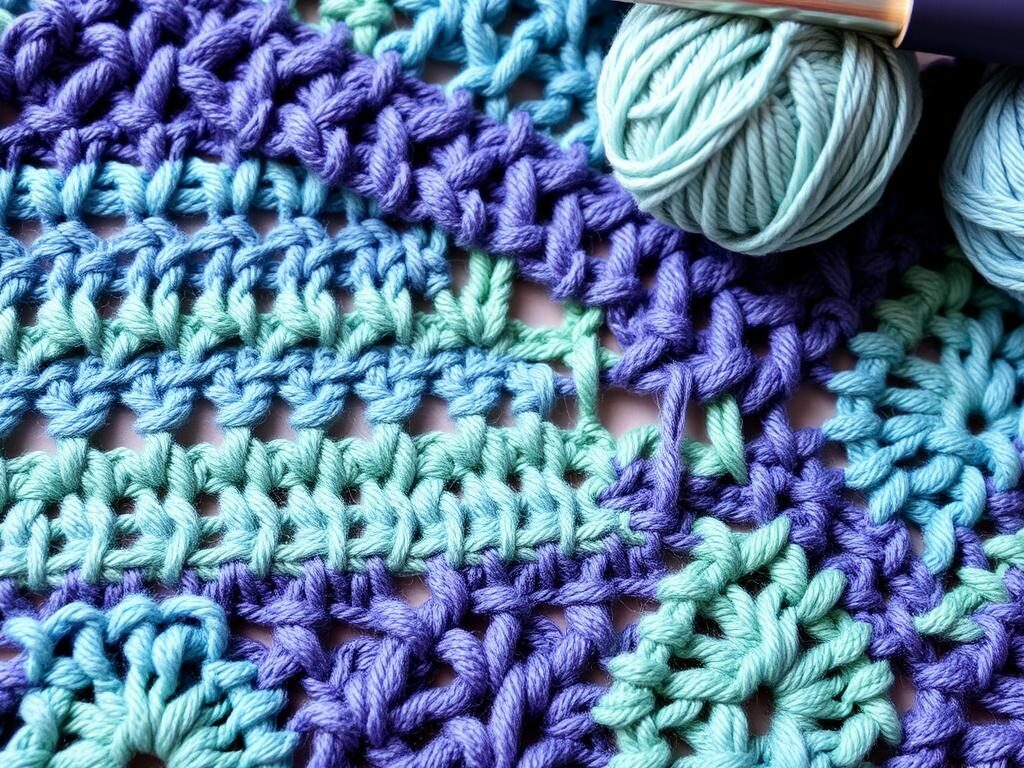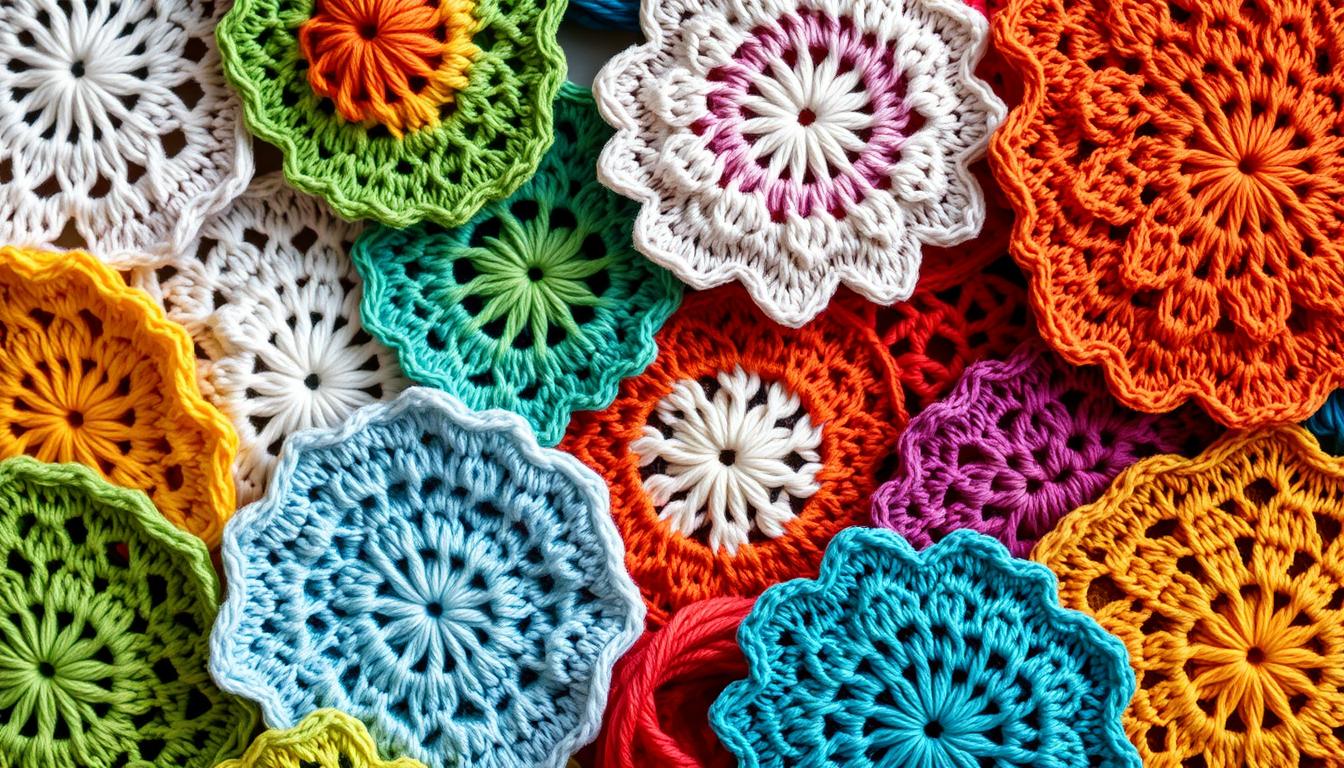Exploring Crochet Stitches: From Basic to Advanced
Crocheting is a delightful journey that allows crafters to express their creativity through a myriad of stitches and techniques. Whether you’re a beginner eager to learn the basics or an experienced artisan ready to delve into advanced patterns, exploring crochet stitches offers an exciting opportunity to enhance your skills and create beautiful pieces. With a wealth of crocheting tutorials available, you can easily navigate through different techniques, mastering everything from simple chains to intricate lacework. Each stitch represents a step in your crafting evolution, bridging the gap between beginner and advanced techniques, and inviting you to expand your repertoire in this wonderful creative hobby. Join us as we dive into the world of crochet, unlocking the potential of yarn and hook alike!
Key Takeaways
- Crochet stitches can be categorized into various types, including basic, textured, combination, lace, Tunisian, and colorwork.
- The choice of crochet stitch affects the fabric’s density, drape, and adherence to pattern requirements.
- Lace crochet stitches and Tunisian crochet stitches offer unique challenges for crafters.
- Crochet provides a wide range of creative possibilities, from cozy blankets to intricate lace patterns.
- Mastering different crochet stitches can open up a world of crochet projects and enhance your needlework skills.
Whether you’re a seasoned crocheter or just starting, this article will guide you. It will help you through the diverse landscape of crochet stitches. You’ll learn to create stunning crochet patterns, yarn crafts, and handmade creations that show your unique style and vision.
Mastering the Basics: Essential Crochet Stitches
Starting your crochet journey means learning the basic stitches. These include the slipknot and the double crochet. They help you make everything from warm afghans to fancy lace pieces.
Starting your crochet journey means learning the basic stitches, which serve as the foundation for more complex projects. Among these essential stitches are the slipknot, chain stitch, single crochet, and double crochet. Mastering these techniques allows you to create a variety of items, from warm afghans perfect for chilly evenings to intricate lace pieces that can adorn your home. Each stitch has its own unique characteristics, making it easier to build your repertoire and explore the endless possibilities within the fiber arts.
As you delve deeper into crochet, you’ll discover how these basic stitches can be combined in countless ways to produce stunning patterns and textures. While knitting techniques often share similarities with crochet, the rhythm and flow of the hook provide a different experience that many crafters find exhilarating. With practice, you can easily transition between knitting and crochet, enriching your creative hobbies and expanding your artistic expression.
The beauty of mastering these foundational stitches lies in their versatility. Once you’ve grasped the basics, you can experiment with color changes, texture variations, and even integrate other crafting techniques to elevate your work. Whether you prefer creating wearable accessories, cozy blankets, or decorative items for your home, these building blocks open up a world of potential within the fiber arts, allowing you to craft personalized pieces that reflect your unique style and taste.
Ultimately, embracing crochet as a creative hobby not only provides a sense of accomplishment but also fosters a community of fellow enthusiasts who share your passion. As you connect with others and share your projects, the joy of crafting multiplies, making even the simplest of stitches feel significant. So grab your hook, gather your yarn, and embark on an exciting journey of creativity and self-expression within the vibrant world of crochet.
Slipknot and Chain Stitches: The Foundation
The slipknot is where you start, securing the yarn to your hook. Then, the chain stitch follows. It lays the groundwork for your project.
Single Crochet: Creating Tight, Dense Fabrics
The single crochet (SC) stitch is simple and makes dense fabrics. It’s great for things like dishcloths and blankets. Remember, in the UK, it’s called a double crochet.
Double Crochet: Loose and Airy Textures
The double crochet (DC) stitch makes fabrics that are loose and airy. It’s perfect for scarves and garments. In the UK, it’s known as a treble crochet.
Learning these stitches is key, whether you’re new or experienced. They give you a strong base to explore crochet. With these basics, you can make beautiful projects that show off your skills.
Textured Crochet Stitches for Visual Interest
Make your crochet projects stand out with textured stitches. There’s more than just single, double, and treble crochet. The bobble stitch and popcorn stitch are great for adding depth and interest.
Bobble Stitch: Dimensional Bumps and Balls
The bobble stitch adds a 3D touch to your crochet. It creates small balls that make your fabric look deeper and more interesting. It’s perfect for blankets, scarves, or accessories, making them look stylish and textured.
Popcorn Stitch: Puffy, Raised Textures
The popcorn stitch is another must-try. It makes your fabric look puffy and raised. It’s great for blankets, pillows, or adding texture to clothes and accessories.
Trying out stitches like bobble and popcorn can make your projects amazing. They add depth and interest beyond basic crochet. Dive into textured crochet and make your handmade items truly special.
Crochet Stitches for Intricate Patterns
As you get better at crochet, you’ll discover intricate crochet patterns and complex stitches. These advanced crochet techniques let you make amazing designs. They include textured elements, combination stitches, and special methods like Tunisian crochet.
Learning these complex crochet stitches opens up a world of creativity. You can try stitches like the Feather Stitch or the Jasmine Stitch. These techniques take time and effort, but they’re worth it for the beautiful results.
- Feather Stitch: Delicate, feathery texture
- Camel Stitch: Raised, textured appearance
- Braid Stitch: Intricate, woven-like pattern
- Star Stitch: Dimensional, star-shaped motifs
- Angel Stitch: Elegant, lace-like design
| Stitch Name | Stitch Type | Level of Difficulty |
|---|---|---|
| Jasmine Stitch | Textured | Advanced |
| Celtic Weave | Intricate | Expert |
| Tinsel Stitch | Decorative | Intermediate |
“Mastering these advanced crochet stitches unlocks a world of creative possibilities.”
Looking to add texture or create stunning patterns? Exploring intricate crochet patterns and complex stitches is rewarding. With time and practice, you’ll elevate your crochet to new levels of advanced crochet techniques.
Exploring Combination Crochet Stitches
Crochet is more than just basic stitches. It’s about trying combination crochet stitches. These stitches mix different types to make unique patterns. Seed stitch and moss stitch are great examples.
Seed Stitch: Alternating Textures
The seed stitch is a classic. It mixes single and double crochet stitches. This creates a bumpy, seed-like texture.
This pattern adds depth and interest to your projects. It’s a favorite for those who love combination stitches.
Moss Stitch: Woven-like Fabrics
The moss stitch is another interesting mix. It uses single crochet and chain stitches. This creates a dense, woven fabric.
The texture is unique and catches the eye. It’s perfect for showing off textured crochet and woven-like fabrics.
“Combination crochet stitches allow you to explore the endless possibilities of this craft, going beyond the basics to create truly unique and visually striking pieces.”
Whether you like the seed stitch’s textures or the moss stitch’s look, trying these stitches is rewarding. It’s a great way to make your crochet projects stand out and show your creativity.

Mastering Lace Crochet Stitches
Crochet lace stitches are timeless, creating delicate designs that look like traditional lace. They use techniques like chaining and skipping to make intricate patterns. From filet crochet to Irish crochet, there’s a lot to explore for crafters.
Filet Crochet: Delicate Grid-like Patterns
Filet crochet is a captivating stitch that makes a fabric look like netting. It uses a grid pattern to create a light, airy texture. This technique is great for many projects, from home decor to clothes.
Irish Crochet: Floral Motifs and Heirloom Beauty
Irish crochet is known for its floral designs. It involves making small crochet pieces that are then joined to make a beautiful item. This stitch is famous for its detailed, three-dimensional look, often with floral motifs.
“Crochet lace patterns offer a timeless and unique appeal, appealing to both beginners and experienced crocheters, making them a popular choice among crafters.”
The Art of Tunisian Crochet
Tunisian crochet, also known as Afghan crochet, blends traditional crochet and knitting. It uses a longer hook with a stopper and works stitches in a special way. This creates a dense, woven fabric with a unique texture.
The collection has 35 different stitches for all skill levels. Each stitch comes with a step-by-step guide. Unlike regular crochet, Tunisian crochet holds a row of stitches on the hook.
It has two main steps: forward pass (fwdP) and return pass (retP). The Tunisian simple stitch (Tss), also known as the afghan stitch, is a beginner’s favorite. You can use rubber bands to turn a regular hook into a Tunisian one.
| Tunisian Crochet Stitch | Description |
|---|---|
| Brick Stitch | A textured stitch pattern with a raised, brick-like appearance. |
| Crochet Ribbing | A versatile stitch that creates a stretchy, ribbed fabric. |
| Diagonal Eyelet Stitch | An open, lacy stitch with a diagonal pattern. |
| Tunisian Puff Stitch | A puffy, dimensional stitch that adds texture and volume. |
| Honeycomb Crochet Stitch | A unique stitch pattern that resembles a honeycomb structure. |
Exploring Tunisian crochet lets you make woven crochet fabrics and try unique crochet techniques. It’s perfect for both beginners and seasoned crafters, offering endless creative possibilities.

Adding Color with Crochet Stitches
Crochet is a great way to express your creativity. One exciting way is through colorwork crochet. Techniques like tapestry crochet and Fair Isle crochet let you use many colors. This creates stunning, colorful designs that grab your attention.
Tapestry Crochet: Intricate Multicolored Designs
Tapestry crochet uses many colors in one row. The colors not in use are carried along the back. This makes intricate, multicolored designs that add depth and interest. With tapestry crochet, you can make your most colorful ideas come to life, from beautiful blankets to stylish accessories.
Fair Isle Crochet: Two-Color Patterns
Fair Isle crochet is similar to tapestry crochet but uses two colors per row. The unused color floats across the back. This creates bold, two-color patterns that make your handmade items stand out. Whether it’s a cozy sweater, a fun hat, or a chic scarf, Fair Isle crochet is a great way to explore colorwork techniques and floating yarn.
Exploring colorwork crochet opens a world of creativity. From the detailed multicolored designs of tapestry crochet to the bold two-color patterns of Fair Isle crochet, the options are endless. By learning these techniques, you can make your crochet projects more interesting, adding depth, texture, and a special touch that will impress everyone.
Crochet Stitches: From Beginner to Advanced
The world of crochet is full of stitches, each with its own look and level of challenge. Beginners start with simple stitches, while more experienced crocheters try out complex ones. Knowing the different types of stitches helps crocheters pick the right ones for their skill level.
Many crocheters want to learn advanced stitches to improve their skills. There are over 100 advanced stitches to try, offering lots of new challenges. Yet, 65% of crocheters find that these stitches are just variations of the basics, making them easier to learn.
For beginners, the Moss Stitch is a good place to start. It has a simple pattern. As you get better, you can try stitches like the Cluster V-stitch for detailed designs or the Waistcoat Stitch for a knit-like look.
Experts say to practice new stitches on small projects first. Then, move on to bigger ones to get better. Also, 92% of crocheters like mixing different stitches to create unique patterns, encouraging them to be creative.
| Crochet Stitch | Skill Level | Characteristics |
|---|---|---|
| Single Crochet | Beginner | Tight, dense fabric |
| Double Crochet | Beginner | Loose, airy texture |
| Popcorn Stitch | Intermediate | 3D textural variation |
| Moss Stitch | Intermediate | Woven-like fabric |
| Tunisian Crochet | Advanced | Unique, knit-like appearance |
Knowing the range of crochet skill levels lets crocheters grow and explore. They can move from beginner crochet stitches to advanced crochet techniques, unlocking new possibilities in this craft.
“Mastering advanced crochet stitches has opened up a new realm of creative expression for me. The ability to blend techniques and textures has truly elevated my crochet projects.”
Conclusion
The world of crochet stitches is vast and full of possibilities. It offers endless chances for creative crochet projects and self-expression. By learning different stitches, from simple to complex, you can add many techniques to your work. This is key for both new and seasoned crocheters to grow and make unique, eye-catching items.
As you explore crochet, enjoy its versatility and let your creativity fly. Find the detailed patterns, textures, and colors that stitches can bring. Use your skills to make amazing projects that show off your style and love for crochet.
Start your crochet adventure with a sense of wonder and a drive to keep learning. Unlock the full potential of crochet stitches. Let your creations amaze and please everyone who sees them. Make crochet a special part of your creative life.
FAQ
What are the basic crochet stitches?
The basic crochet stitches include the slipknot, chain, single crochet, and double crochet. These stitches are the foundation for every crocheter. They are the building blocks for more advanced techniques.
What is the difference between single crochet and double crochet?
The single crochet stitch makes a neat, even fabric with few holes. The double crochet stitch makes a more open and flexible fabric. It’s important to know the difference in US and UK crochet patterns.
What are textured crochet stitches?
Textured crochet stitches, like the bobble stitch and popcorn stitch, add visual interest. They create raised, bumpy, or intricate textures. These stitches go beyond the basic single, double, and treble crochet.
What are some examples of advanced crochet stitches?
As you get better at crochet, you can try more intricate stitches. This includes combination stitches, lace crochet, and Tunisian crochet. Tunisian crochet combines crochet and knitting elements.
How can I incorporate color into my crochet projects?
Colorwork crochet stitches, like tapestry and Fair Isle crochet, let you create intricate designs. You work with multiple colors in one project. These techniques use unused colors to make stunning, vibrant patterns.
What is the difference between beginner and advanced crochet stitches?
Crochet stitches vary in difficulty. Beginners start with simple stitches. As skills improve, crocheters can try more complex stitches. This includes textured, combination, lace, and Tunisian crochet stitches.
Source Links
- Exploring the Types of Crochet Stitches: A Comprehensive Guide – https://www.smart-knit-crocheting.com/types-of-crochet-stitches.html
- Freeform Crochet Basics: The Ultimate Beginner’s Guide – https://cypresstextiles.net/2019/05/29/freeform-crochet-basics-the-ultimate-beginners-guide-featuring-abstract-blocks-and-much-more/
- Easy Crochet Stitch Library of 30 Stitches for Beginners and More – Easy Crochet Patterns – https://easycrochet.com/crochet-stitches/
- Basic Crochet Stitches Every Beginner Needs – Mama In A Stitch – https://www.mamainastitch.com/basic-crochet-stitches-for-beginners/
- Basic Crochet Stitches – Icrochets and Knits – https://icrochets.com/2024/08/24/basic-crochet-stitches/
- Texture 101: How to Incorporate New Stitches into Your Crochet Items – Including 9 Free Stitch Patterns! – https://cypresstextiles.net/2022/01/13/texture-101-how-to-incorporate-new-stitches-into-your-crochet-items-including-9-free-stitch-patterns/
- 5 Unique Textured Crochet Stitches – https://thisiscrochet.com/textured-crochet-stitches/
- Your complete library of crochet stitches – https://www.gathered.how/knitting-and-crochet/crochet/crochet-stitches
- 27 Advanced Crochet Stitches You Need to Try – https://desertblossomcrafts.com/advanced-crochet-stitches/
- 30+ Stunning Crochet Stitches – https://www.crochet365knittoo.com/crochet-stitches/
- Tall and Long Crochet Stitches Tutorial – https://www.hanjancrochet.com/long-crochet-stitches/
- Free resources to get you started making Irish Crochet Lace – https://rovingcrafters.com/2016/04/21/free-resources-to-get-you-started-making-irish-crochet-lace/
- Gorgeous Crochet Lace Patterns – https://www.crochet365knittoo.com/crochet-lace/
- Struggling to master the art of crochet lace patterns? This simple step will get your lace looking delicate and intricate every time! – http://diyeverywhere.com/2024/02/14/struggling-to-master-the-art-of-crochet-lace-patterns-this-simple-step-will-get-your-lace-looking-delicate-and-intricate-every-time/
- Best Tunisian Crochet Stitches- Photo,Video Tutorials & Free Patterns – https://makeanddocrew.com/tunisian-crochet-stitches-video-tutorials/
- Week #9: Tunisian Basics Crochet-Along – https://hearthookhome.com/week-9-tunisian-basics-crochet-along/
- How to Seamlessly Change Yarn Colors in Crochet Tutorial – https://theloopylamb.com/how-to-seamlessly-change-yarn-colors-in-crochet-tutorial/
- How to Change Colors in Crochet (Rows and Rounds) – https://sarahmaker.com/change-colors-crochet/
- The Best 45+ Advanced Crochet Stitches – Crochet and Stitches – https://www.crochetandstitches.com/advanced-crochet-stitches/
- Advanced Crochet Stitches – Ultimate List – Nicki’s Homemade Crafts – https://www.nickishomemadecrafts.com/crochet/advanced-crochet-stitches/
- Crochet Stitches for Intermediate & Advance level – Moara Crochet – https://moaracrochet.com/crochet-stitches/
- Ms Premise-Conclusion – https://mspremiseconclusion.wordpress.com/
- Free Patterns – Ms Premise-Conclusion – https://mspremiseconclusion.wordpress.com/category/free-patterns/
- Mastering Crochet Stitches: Tips for Consistency and Neatness – https://www.gillianlarmond.com/crochet-stitches/

